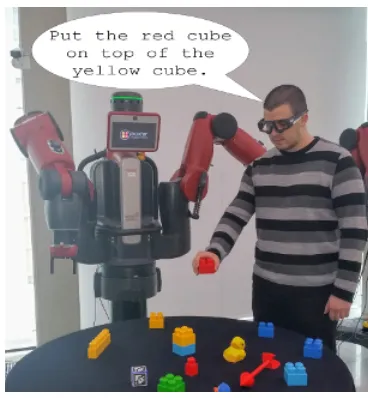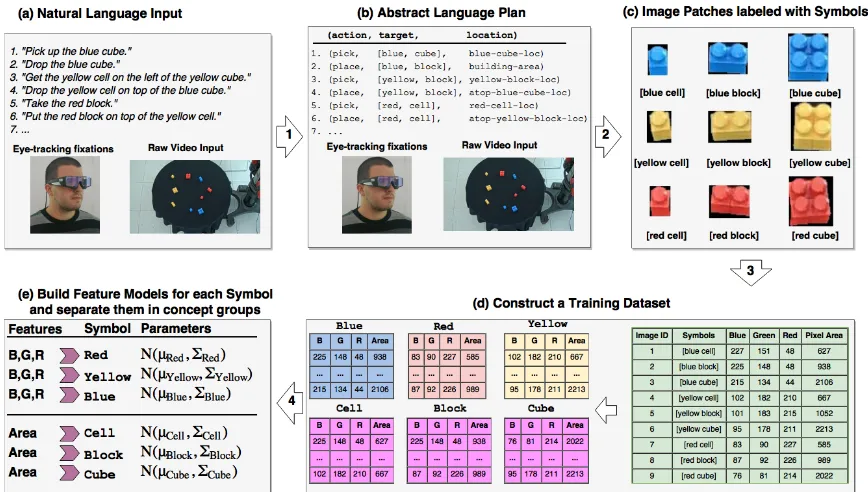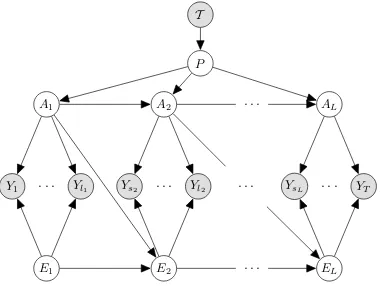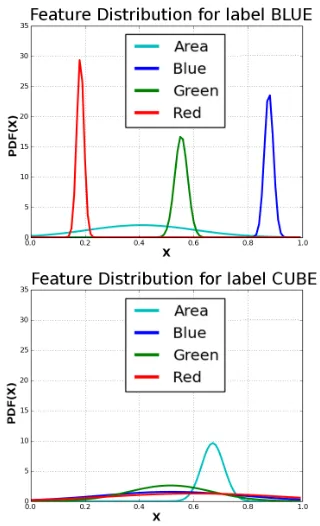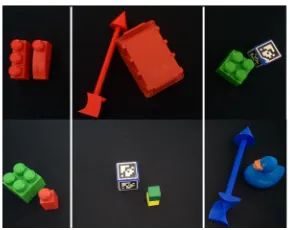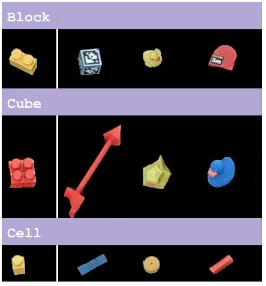Grounding Symbols in Multi-Modal Instructions
Yordan Hristov, Svetlin Penkov, Alex Lascarides and Subramanian Ramamoorthy School of Informatics
The University of Edinburgh
{yordan.hristov@, sv.penkov@, alex@inf., s.ramamoorthy@}ed.ac.uk
Abstract
As robots begin to cohabit with humans in semi-structured environments, the need arises to understand instructions involv-ing rich variability—for instance, learninvolv-ing to ground symbols in the physical world. Realistically, this task must cope with small datasets consisting of a particular users’ contextual assignment of meaning to terms. We present a method for process-ing a raw stream of cross-modal input— i.e., linguistic instructions, visual percep-tion of a scene and a concurrent trace of 3D eye tracking fixations—to produce the segmentation of objects with a cor-respondent association to high-level con-cepts. To test our framework we present experiments in a table-top object manip-ulation scenario. Our results show our model learns the user’s notion of colour and shape from a small number of phys-ical demonstrations, generalising to iden-tifying physical referents for novel combi-nations of the words.
1 Introduction
Effective and efficient human-robot collaboration requires robots to interpret ambiguous instructions and concepts within a particular context, commu-nicated to them in a manner that feels natural and unobtrusive to the human participant in the inter-action. Specifically, the robot must be able to:
• Understand natural language instructions, which might be ambiguous in form and meaning.
[image:1.595.323.507.219.418.2]• Ground symbols occurring in these instruc-tions within the surrounding physical world.
Figure 1: Combining natural language input with eye tracking data allows for the dynamic labelling of images from the environment with symbols. The images are used in order to learn the meaning of language constituents and then ground them in the physical world.
• Conceptually differentiate between instances of those symbolic terms, based on features pertaining to their grounded instantiation, e.g. shapes and colours of the objects.
Being able to relate abstract symbols to obser-vations with physical properties in the real world is known as the physical symbol grounding problem (Vogt,2002); which is recognised as being one of the main challenges for human-robot interaction and constitutes the focus of this paper.
There is increasing recognition that the mean-ing of natural language words derives from how they manifest themselves across multiple modali-ties. Researchers have actively studied this prob-lem from a multitude of perspectives. This in-cludes works that explore the ability of agents to interpret natural language instructions with respect
to a previously annotated semantic map (Matuszek et al.,2013) or fuse high-level natural language in-puts with low-level sensory observations in order to produce a semantic map (Walter et al., 2014).
Matuszek et al. (2014); Eldon et al. (2016) and
Kollar et al.(2013) tackle learning symbol ground-ing in language commands combined with gesture input in a table-top scenario. However, all these approaches depend on having predefined specifi-cations of different concepts in the environment: they either assume a pre-annotated semantic map with respect to which they ground the linguistic in-put or have an offline trained symbol classifier that decides whether a detected object can be labelled with a specific symbol; e.g. colour and shape in (Matuszek et al.,2014). Thus in order to deploy such a system, one should have access to an al-ready trained classifier for every anticipated sym-bol, prior to any user interaction.
Multi-modal learning algorithms based on deep neural networks are also popular for grounding natural language instructions to the shared phys-ical environment (Srivastava and Salakhutdinov,
2012; Ngiam et al., 2011). But the majority of these algorithms depend crucially on large and pre-labelled datasets, and the challenge is in col-lecting these large-scale labelled datasets so that they not only capture the variability in language but also manage to represent the nuances (espe-cially across multiple high-bandwidth modalities, such as vision and eye-tracking) of inter-personal variability in assignment of meaning (e.g., what one person calls mustard another might call yel-low), which we claim is a key attribute of free-form linguistic instructions in human-robot inter-action applications. If a previously unseen instruc-tion/visual observation is presented to these sys-tems, they might fail to ground or recognize them in the way that the user might have intended in that specific setting.Tobin et al.(2017) potentially by-passes the need to collect a big dataset by demon-strating that a model trained in simulation can be successfully deployed on a robot in the real world. However, the problem is then shifted to generating task-specific training data in a simulator which ap-proximates the real world well enough.
A proposed alternative to this off-line learn-ing approach is to interactively teach an embod-ied agent about its surrounding world, assuming limited prior knowledge. Al-Omari et al. (2016) demonstrates a model for incrementally learning
the visual representation of words, but relies on temporally aligned videos with corresponding an-notated natural language inputs. Parde et al.
(2015) and Thomason et al.(2016) represent the online concept learning problem as a variation of the interactive “I Spy” game. However, these approaches assume an initial learning/exploratory phase in the world and extracted features are used as training data for all concept models associated with an object.
Penkov et al.(2017) introduce a method called GLIDE (see§2.2 for details), which successfully teaches agents how to map abstract instructions, represented as a LISP-like program, into their physical equivalents in the world. Our work builds on this method: it uses it to achieve natural lan-guagesymbol grounding, as a by-product of user interaction in a task-oriented scenario. Our ap-proach achieves the following:
• It maps natural language instructions to a planned behaviour, such as in a robotic ma-nipulation domain; in so doing it supports a communication medium that human users find natural.
Figure 2: Overview of the full system pipeline. Input to the system are natural language instructions, together with eye-tracking fixations and a camera view of the world from above(a) Natural language instructions are deterministically parsed to an abstract plan language (b)Using the abstract plan, a set of labelled image patches is produced from the eye-tracking and video data(c)Observable predefined features are extracted from the image patches(d) Each symbol is grounded to a subset of observable features(e)
the human participant is simultaneously teaching the robot how to execute a task and what prop-erties the surrounding objects must have for that execution to be successful. For instance, while observing how to make a fruit salad in a kitchen, apart from learning the sequence of steps, the sys-tem would also gain an initial approximation of the visual appearance of different pieces of fruit and their associated natural language symbols.
2 Methods
Figure2depicts the architecture of the overall sys-tem. It consists of an end-to-end process, from raw linguistic and video inputs on the one hand to learned meanings of symbols that in turn are con-ceptually grouped: i.e., a symbol can correspond either to an object in the real world, or to a prop-erty of an object. The rest of the section is orga-nized in the following fashion - each subsection corresponds to a numbered transition (1 to 4) indi-cated in Figure2.
2.1 Natural Language Semantic Parsing
The task of the semantic parser is to map nat-ural language requests into instructions
repre-sented in an abstract form. The abstract form we use is a list of tuples with the format (action target location) (Figure 2b), where action corresponds to an element from a predefined setA,targetcorresponds to a list of terms that describe an object in the world and locationcorresponds to a single symbol denot-ing a physical location in the environment.
The narration of the plan execution by the hu-man comprises one sentence per abstract instruc-tion. Therefore, given a plan description, our se-mantic parser finds a mapping from each sentence to a corresponding instruction as defined by our abstract plan language.
Figure 3: Example of dependency graphs for input sentences. Red labels denote the top graph nodes.
• The graph is extracted from nodes and their respective edges, cleaning up nodes and edges that do not contribute directly to the meaning of the instruction—i.e., anything that is not a verb, adjective, preposition or a noun;
• The processed graph is recursively traversed until all nodes have been visited at least once.
Knowing the format of our abstract plan lan-guage, we know that action would always correspond to the verb in the input sentence, targetwould correspond to a noun phrase and location would correspond to a prepositional phrase (i.e., a combination of a preposition and noun phrase). For us, the noun phrases all con-sist of a noun, complemented by a possibly empty list of adjectives. Extracting the action is straight-forward since the top node in the EDS always cor-responds to the verb in the sentence; see Figure3. The extracted action is then passed through a pre-defined rule-based filter which assigns it one of the values fromA: e.g. pick, grab, take, getwould all be interpreted aspick.
The targetentry can be extracted by identi-fying noun node in the EDS that’s connected to the verb node. Once such a noun is found, one can identify its connections to any adjective nodes— this gives a full list of symbols that define the ob-ject referenced by thetarget.
The location entry can be extracted by searching for preposition nodes in the EDS that are connected to the verb node. If there is no such node, then thelocationis constructed di-rectly from the target by concatenating its labels - e.g. for a blue cube the locationwould be the symbol blue-cube-location. Extract-ing the location from a prepositional phrase is less constrained since different verbs can be related to spatial prepositions in varied ways— either the preposition node has an edge
connect-ing it to the verb node or vice versa. Once a prepositional node is visited, we proceed by re-cursively exploring any chains of interconnected nouns, prepositions, and adjectives. The recursion calls for backtracking whenever a node is reached with no unvisited incoming or outgoing edges: e.g., nodecubeon Figure3(bottom). For exam-ple, the symbolon-left-of-cubeis produced forlocationfor the bottom sentence in Figure
3.
In this way, the result of parsing is a sequence of abstract instructions—i.e., an abstract plan— together with asymbol setS, containing all sym-bols which are part of anytargetentry. At this point, the symbols are still not actually grounded in the real world. Together with the raw video feed and the eye-tracking fixations, the abstract plan becomes an input to GLIDE (Penkov et al.,2017).
2.2 Grounding and Learning Instances through Demonstration and Eye tracking (GLIDE)
Penkov et al. (2017) introduce a framework for Grounding and Learning Instances through Demonstration and Eye tracking (GLIDE). In this framework, fixation programs are repre-sented in terms of fixation traces obtained dur-ing task demonstrations combined with a high-level plan. Through probabilistic inference over fixation programs, it becomes possible to infer latent properties of the environment and deter-mine locations in the environment which corre-spond to each instruction in an input abstract plan that conforms to the format discussed above -(action target location).
2.2.1 3D Eye-Tracking
Y1 . . . Yl1 Ys2 . . . Yl2 . . . YsL . . . YT
A1 A2 AL
E1 E2 EL
. . .
. . . P
[image:5.595.86.277.62.205.2]T
Figure 4: The proposed probabilistic model for physical symbol grounding is based on the idea that “task and context determine where you look” (Rothkopf et al.,2007).
an additional camera may be attached to augment an eye-tracker, by running mono camera SLAM algorithm in the background—ORBSLAM ( Mur-Artal et al., 2015). The SLAM algorithm pro-vides 6D pose of the eye tracking glasses within the world frame; this allows for the fixation lo-cations to be projected into the 3D world by ray casting and finding intersections with a 3D model of the environment. As a result, fixations can be represented as 3D locations, enabling the projec-tion of fixaprojec-tions in the frame of any sensor in the environment.
2.2.2 Model and Location Inference
In order to solve the problem of symbol ground-ing, inference is performed using a generative probabilistic model, which is shown in Figure4. The sequence of fixations Y1 : YT depend both
on the current environment stateE and the action being executedA. Each action is part of the plan P which is determined by the task being demon-stratedT. The sequence of fixations is observed and interpreted with respect to a task that is by this stage already known, while the state of the environment and the current action are unknown. The main inference task is to determine the struc-ture of the model and assign each fixation to the action that is its cause. A crucial feature of this procedure is the fact, deriving from human sen-sorimotor behaviour, that the distribution of fix-ations is different when a person is attending to the execution of an action compared to periods of transitions between actions in the plan. By utilis-ing this property and usutilis-ing samples from a Dirich-let distribution to describe these transition points, GLIDE is able to infer the correct partitioning of
Algorithm 1:Symbol Meaning Learning
Input:σthresh Data:I,S,F
Output: K={(µ1,Σ1), . . . ,(µS,ΣS)},
C={(Fs
invar :s), . . .(FinvarS :S)}
1 Data←[s1 :{}, . . . , sS :{}]; 2 forimageiinI do
3 symbolsi ←GetSymbols(i); 4 featuresi←ExtractF eatures(i); 5 forsymbolinsymbolsido
6 AppendfeaturesitoData[symbol];
7 forsinS do
8 Ks←F itNormal(Data[s]); 9 Ks←CleanNoise(Data[s]);
10 Finvars ←F indInvF eat(Ks, σthresh); 11 Ks←RefitNormal(Ks, Finvars ); 12 Append(Finvars :Ks)toC;
the fixation sequence. This information allows us to localise each item of interest in the environment and extract labelled sensory signals from the en-vironment. A complete description of this model and inference procedure can be found in (Penkov et al.,2017).
2.3 Feature Extraction
The parser produces a set of symbols S and GLIDE produces a set of image patchesI, each of which is labelled with a subset of symbols from S. We proceed by extracting a number of fea-tures, drawn from a pre-existing set F. The fea-tures are derived from the objects in the image patches, after removing the background. This is achieved through a standard background subtrac-tion method—we know that the majority of the im-age will be occupied by a solid object with a uni-form colour, anything else is a background. For in-stance, in the image patches in Figure2(c), the ob-jects are the colourful blocks and the background is the black strips around them. Images containing only or predominantly background are considered noise in the dataset and are discarded. For each symbol s we group the extracted features from each image labelled withsresulting in S lists of Mstuples withF entries in each tuple, whereMs
[image:5.595.306.527.72.308.2]Figure 5: Example of feature distributions for blue(top) andcube(bottom) symbols.
2.4 Symbol Meaning Learning
For each symbol s ∈ S and each feature f ∈ F we fit a 1-D Normal distribution resulting in a new list of tuples with size F - sj :
[(µsj
f1, σ
sj
f1), . . . ,(µ
sj
fF, σ
sj
fF)] for the jth symbol.
Taking into account that the object location pro-cess in GLIDE could still produce noisy results— i.e., the label of an image can be associated with the wrong symbol—we process our distributions to refit them to data that falls within two standard deviations from the means of the original distri-butions. We are then seeking observed featuresf that are invariant with respect to each token use of a specific symbolswithin the user instructions so far—i.e. their distributions are ‘narrow’ and with variance below a predefined thresholdσthresh(see
Figure5). If we have a set of images that are of blue objects with different shapes and we extract a set of features from them, we would expect that features with lower variation (e.g. RGB channels as opposed to area) would explain the colour blue better than features with more variation (i.e. pixel area).
In the last step, we construct a set of the invari-ant features from the discovered narrow distribu-tions for a given symboll-(Fs
invar)- and say that
this set characterizes the symbol. The parameters for the symbol are the concatenation of the means
of the features from (Fl
invar) into a mean vector
and the concatenation of the variances into a diag-onal covariance matrix. The resultant mean vector and covariance matrix are later used for inference when shown a new set of images.
3 Experiments
We now present results from initial experiments based on the framework in Figure 2. We focus our explanation on steps 3 and 4 in that figure, as these are the pertinent and novel elements intro-duced here. The input data for Figure2(c) is de-rived from the process already well described in (Penkov et al.,2017).
3.1 Dataset
For our experiments we used a total of six symbols defining S: 3 for colour (red, blue and yellow); and 3 for shape (cell, block, cube). We used four extracted features forF: R, G, B values and pixel area. The objects used were construction blocks that can be stacked together and images of them were gathered in a tabletop robotic manipulation setup (see Figure 2 (a)). Based on the empiri-cal statistics of the recognition process in (Penkov et al., 2017), our input dataset to the Symbol Meaning Learning algorithm consists of 75% cor-rectly annotated and 25% mislabelled images. The total training dataset comprised of approximately 2000 labelled image patches, each of which is labelled with two symbols—e.g. blue cell, red block,yellow cube, etc.
The additional test set was designed in two parts: one that would test colour recognition and one that would test shape recognition. Overall, 48 objects were presented to the algorithm where the features for each object would fall into one of the following categories:
• Previously seen features (Figure6(left)) • Previously unseen features, close to the
fea-tures of the training data (Figure6(middle)) • Previously unseen features, not close to the
features of the training data (Figure6(right))
3.2 Experimental Set up
[image:6.595.100.260.63.326.2]Figure 6: Variations in the objects from the test set for colour (top half) and shape (bottom half)
given that the algorithm was trained on 3 colours and 3 shapes, we would expect that it should rec-ognize different hues of the 3 colours and objects with similar shapes to the original 3; however, it may not be able to recognize objects with com-pletely different features. Moreover, we further group different symbols into concept groups. If any two symbols are described by the same fea-tures, it is safe to assume that those two symbols are mutually exclusive: that is, they can not both describe an object simultaneously. Thus we go over each concept group and if there are symbols yielding PDF values above a predefined threshold, we assign the new image the symbol from that group with the highest PDF.
3.3 Results
[image:7.595.105.250.62.177.2]The system successfully learns from the training dataset that the colour symbols are being char-acterized by the extracted RGB values, while (in contrast) the shape symbols from the pixel area of the image patch—see Figure7. Given a new test image with its extracted features, the algorithm recognises 93% of presented colours and 56% of presented shapes. Tables1 and2 report the con-fusion matrices for the testing set. This shows that the system is more robust when recognizing colours than when recognizing shapes. This can be attributed to the fact that while RGB values de-scribe the concept of colour well enough, simply the pixel area is not enough to describe the con-cept of shape. Therefore the algorithm confuses the rubber duck with a cell, for example, and the arrow with a cube, see Figure 8, principally be-cause they are of a similar size to each other! In future work, we would consider a wider range of features being extracted from the images, which in turn would support a finer-grained discrimination among objects.
Table 1: Confusion matrix for colour symbols
Red Yellow Blue Unknown
Red 12 1 0 0
Yellow 0 12 0 0
Blue 0 0 13 1
[image:7.595.305.531.76.248.2]Unknown 0 1 0 13
Table 2: Confusion matrix for shape symbols
Cell Block Cube Unknown
Cell 8 1 0 0
Block 1 7 0 0
Cube 0 3 8 0
Unknown 5 5 6 4
4 Discussion and Future Work
The experiments in this paper have demonstrated that it is possible to train classifiers for object appearance alongside symbols, which are anal-ysed via a semantic parser, to achieve ground-ing of instructions that respect the specificity of the scenario within which that association derives its meaning. Although our framework supports an entire pipeline, from raw cross-modal input to an interpreted and grounded instruction, the pre-sented scenarios are simple and the specific meth-ods could be made (much) more sophisticated. Despite this, we claim that this provides step-ping stones towards learning more complex lan-guage structures in the future: during the first few demonstrations a human could teach a robot fun-damental concepts like colours, shapes, orienta-tion, and then proceed to use this newly gained knowledge to ground, e.g., prepositional phrases (Forbes et al.,2015;Rosman and Ramamoorthy,
2011) or actions (Misra et al.,2016; Zampogian-nis et al., 2015) in an online and context specific manner. Once the system knows what blue cubes look like, it would be easier to learn what it means for another cube to be on top of/around it.
Figure 7: Excerpt from the testing dataset of objects whose colour and shape were correctly recognised.
Figure 8: Examples of wrongly assigned known symbols to unseen shapes. Leftmost objects demonstrate an object from the training data.
is unknown, the system can prompt the human for new linguistic input which together with its fea-ture model is added to the knowledge base and allows for its future recognition. For example, if the robot observes a new hue of blue it would up-date its parameters forblue to account for that; whereas if it observes a new colour (e.g. green) it would ask the human for the unknown symbol and would record it for future reference.
The idea of teaching the system about com-pound nouns is also a relevant challenge and a possible extension of this work: our current setup relies on noun phrases consisting of predicative Adjs and a Noun (e.g. blue cube), and so we know that the associated image patchX satisfies both the adjective and the noun—i.e., blue(X) andcube(X) are both true. However, this would not apply to a compound noun like steak knife: we know that the associated image patch X sat-isfiesknife(X) but does not satisfy steak(X).
Refinements to our model would be necessary in order to represent more complex symbol relations, e.g. in a hierarchical fashion (Sun et al.,2014).
5 Conclusion
We present a framework for using cross-modal in-put: a combination of natural language instruc-tions, video and eye tracking streams, to simulta-neously perform semantic parsing and grounding of symbols used in that process within the physi-cal environment. This is achieved without reliance on pre-existing object models, which may not be particularly representative of the specifics of a particular user’s contextual usage and assignment of meaning within that rich multi-modal stream. Instead, we present an online approach that ex-ploits the pragmatics of human sensorimotor be-haviour to derive cues that enable the grounding of symbols to objects in the stream. Our prelim-inary experiments demonstrate the usefulness of this framework, showing how a robot is not only able to learn a human’s notion of colour and shape, but also that it is able to generalise to the recogni-tion of these features in previously unseen objects from a small number of physical demonstrations.
Acknowledgments
[image:8.595.116.249.277.420.2]References
M Al-Omari, P Duckworth, DC Hogg, and AG Cohn. 2016. Natural language acquisition and grounding for embodied robotic systems. InProceedings of the 31st Association for the Advancement of Artificial Intelligence. AAAI Press.
Ann Copestake, Dan Flickinger, Carl Pollard, and Ivan A Sag. 2005. Minimal recursion semantics: An introduction. Research on Language and Computa-tion3(2-3):281–332.
Miles Eldon, David Whitney, and Stefanie Tellex. 2016. Interpreting multimodal referring expres-sions in real time. In International Conference on Robotics and Automation.
Dan Flickinger, Emily M. Bender, and Stephan Oepen. 2014. ERG semantic documentation. Accessed on 2017-04-29. http://www.delph-in.net/esd.
Maxwell Forbes, Rajesh PN Rao, Luke Zettlemoyer, and Maya Cakmak. 2015. Robot programming by demonstration with situated spatial language under-standing. InRobotics and Automation (ICRA), 2015 IEEE International Conference on. IEEE, pages 2014–2020.
Thomas Kollar, Jayant Krishnamurthy, and Grant P Strimel. 2013. Toward interactive grounded lan-guage acqusition. InRobotics: Science and Systems.
Cynthia Matuszek, Liefeng Bo, Luke Zettlemoyer, and Dieter Fox. 2014. Learning from unscripted deictic gesture and language for human-robot interactions. InAAAI. pages 2556–2563.
Cynthia Matuszek, Evan Herbst, Luke Zettlemoyer, and Dieter Fox. 2013. Learning to parse natural lan-guage commands to a robot control system. In Ex-perimental Robotics. Springer, pages 403–415.
Dipendra K Misra, Jaeyong Sung, Kevin Lee, and Ashutosh Saxena. 2016. Tell me dave: Context-sensitive grounding of natural language to manip-ulation instructions. The International Journal of Robotics Research35(1-3):281–300.
Marcin Morzycki. 2013. Modification. Book
manuscript. In preparation for the Cambridge Uni-versity Press series Key Topics in Semantics and Pragmatics.http://msu.edu/ morzycki/work/book.
Ra´ul Mur-Artal, J. M. M. Montiel, and Juan D.
Tard´os. 2015. ORB-SLAM: a versatile and
accurate monocular SLAM system. IEEE
Transactions on Robotics 31(5):1147–1163.
https://doi.org/10.1109/TRO.2015.2463671. Jiquan Ngiam, Aditya Khosla, Mingyu Kim, Juhan
Nam, Honglak Lee, and Andrew Y Ng. 2011. Multi-modal deep learning. InProceedings of the 28th in-ternational conference on machine learning (ICML-11). pages 689–696.
Stephan Oepen, Dan Flickinger, Kristina Toutanova, and Christopher D Manning. 2004. Research on Language and Computation2(4):575–596.
Natalie Parde, Adam Hair, Michalis Papakostas, Konstantinos Tsiakas, Maria Dagioglou, Vangelis Karkaletsis, and Rodney D Nielsen. 2015. Ground-ing the meanGround-ing of words through vision and inter-active gameplay. InIJCAI. pages 1895–1901. Svetlin Penkov, Alejandro Bordallo, and Subramanian
Ramamoorthy. 2017. Physical symbol grounding and instance learning through demonstration and eye tracking .
Benjamin Rosman and Subramanian Ramamoorthy. 2011. Learning spatial relationships between ob-jects. The International Journal of Robotics Re-search30(11):1328–1342.
Constantin A Rothkopf, Dana H Ballard, and Mary M Hayhoe. 2007. Task and context determine where you look. Journal of vision7.
Nitish Srivastava and Ruslan R Salakhutdinov. 2012. Multimodal learning with deep boltzmann ma-chines. InAdvances in neural information process-ing systems. pages 2222–2230.
Yuyin Sun, Liefeng Bo, and Dieter Fox. 2014. Learn-ing to identify new objects. In Robotics and Au-tomation (ICRA), 2014 IEEE International Confer-ence on. IEEE, pages 3165–3172.
Jesse Thomason, Jivko Sinapov, Maxwell Svetlik, Pe-ter Stone, and Raymond J Mooney. 2016. Learning multi-modal grounded linguistic semantics by play-ing i spy. InProceedings of the Twenty-Fifth inter-national joint conference on Artificial Intelligence (IJCAI).
Josh Tobin, Rachel Fong, Alex Ray, Jonas Schneider, Wojciech Zaremba, and Pieter Abbeel. 2017. Do-main randomization for transferring deep neural net-works from simulation to the real world. arXiv preprint arXiv:1703.06907.
Paul Vogt. 2002. The physical symbol grounding prob-lem. Cognitive Systems Research3(3):429–457. Matthew R Walter, Sachithra Hemachandra, Bianca
Homberg, Stefanie Tellex, and Seth Teller. 2014. A framework for learning semantic maps from grounded natural language descriptions. The Inter-national Journal of Robotics Research33(9):1167– 1190.
